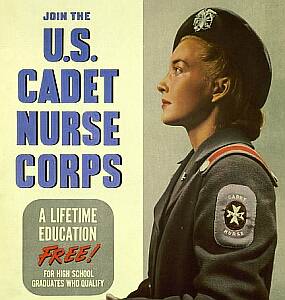 |
...... |
Since it was intended to recruit as many women as possible, the
requirements for joining the Corps were not set high. Every woman between
17 and 35 years of age with high school education (having good scholastic
records) and in good health could apply.
Application for marriage and marriage as a student was permitted,
provided that the guidelines of the attended school were followed. This
was an important concession. Many young women wanted to get married before
their boyfriends had to leave for service duty away from home. |
.
...
| Upon joining the Corps, every woman had to give an induction pledge.
The pledge was rather a statement of good intentions than a legal contract. |
.
|
Induction Pledge
At this moment of my induction into the United
States Cadet Nurse Corps of the United States Public Health Service:
I am solemnly aware of the obligations
I assume toward my country and toward my chosen profession;
I will follow faithfully the teachings
of my instructors and the guidance of the physicians with whom I work;
I will hold in trust the finest
traditions of nursing and the spirit of the Corps;
I will keep my body strong, my mind
alert, and my heart steadfast;
I will be kind, tolerant, and understanding;
Above all, I will dedicate myself
now and forever to the triumph of life over death;
As a Cadet nurse, I pledge to my county my
service in essential nursing for the duration of the war. |
.
Training
.
The course of nurse practice and study required for graduation was
reduced to 24 to 30 months (instead of the traditional thirty-six months).
Despite the expedited training, it was pronounced that Cadet Nurses would
received the same complete education as other nurse students and would
be eligible as registered nurses after graduation. However, in reality,
it was impossible to keep the same high standard usually necessary for
prewar graduation because these nurse candidates underwent shortened emergency
wartime training that sometimes was several months less than the officially
announced 24-30 months period.
.
.
| Ideally, during the first 9 months, the nurse students were „Pre-Cadets“,
traditionally known as „Probies“. They attended mainly demonstrations,
but also started with nurse practice that included supervised work in hospital
wards, classroom and laboratory work. |
..... |
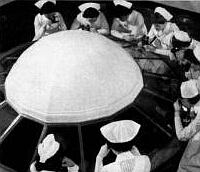
Cadet Nurses in the operation
theatre |
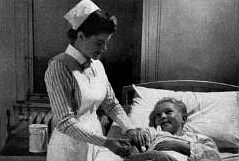 Practice in pediatrics
Practice in pediatrics
|
... |
For the next 15 to 24 months, the students became Junior Cadets.
They spent less time in the classroom and more time in clinical practice,
especially in medical and surgical nurse duties, in operating rooms and
outpatient departments. In this way, they learned on the job. For example,
they administered drugs and treatments and assisted physicians. |
| During the final last 6 months of training, members of the Corps
were Senior Cadets. Under supervision, they assumed responsibility and
duties of a graduate nurse.
They were required to work a 48-hour week like all government employees
during the war. Few or sometimes no classes were given during their on-duty
time. Therefore, some of the off-duty time had to be used for learning
as well.
The Senior Cadets were placed where they were most needed. Most of
them served in civilian, federal or military hospitals. Other students
spent their Senior Cadet period in the Indian, Public Health or Rural Health
Services on reservations and remote locations.
In many cases, because of pressing wartime requirements, these training
stages were drastically cut in the amount of time spent in each phase. |
... |
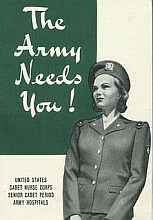 -
This Army recruitment brochure
tries to convince Cadet Nurses to do their senior cadet period in an Army
Hospital
-
This Army recruitment brochure
tries to convince Cadet Nurses to do their senior cadet period in an Army
Hospital
|
.
.
| Assignments of Senior Cadets |
Number |
| Military Hospitals |
7,466 |
| Army |
6,358 |
| Navy |
1,106 |
| Other Federal hospitals |
10,009 |
| Veteran's Administration |
7,907 |
| Marine hospitals, Public Health Service |
974 |
| Indian service |
1,128 |
| Non-Federal hospitals |
94,378 |
| Hospitals where Cadet was trained |
85,171 |
| Other hospitals with schools of nursing |
4,448 |
| Other hospitals with no school of nursing |
4,759 |
| Public health nursing agency |
2,162 |
| Not reported |
1,990 |
| Other nursing service |
714 |
| Grand total |
116,717 |
.
(Source: The United States Cadet Nurse Corps and other
Federal Nurse Training Programs)
After finishing the senior stage, Cadet Nurses received a diploma
from the nursing school where they had started their training. Nevertheless,
a graduate Cadet Nurse had to pass the rigorous State Board examination
before she could become a Registered Nurse (RN), as prewar standards were
upheld for RN requirements. Few took this final step during the war, because
they could commence nurse work upon graduation without the RN license.
.
Payment
.
Cadet nurses received federal funds for tuition, board, room and uniforms
(indoor and outdoor). Additionally, a regular monthly allowance of $15
was paid during the first nine months of training.
Cadet nurses received $20 a month money allowance for the next fifteen
to twenty-one months (Junior Cadet stage).
In the last 6 months of training (Senior Cadet Stage) the stipend
was not less than $30 per month. It had to be paid by the institution using
the service of the Senior Cadet nurse. Army and Navy hospitals paid $60
each month.
.
Cadet Nurse March
.
The Cadet Nurse Corps also had an own Cadet Nurse March which was sung
on several occasions as for example war bond rallies and parades.
.
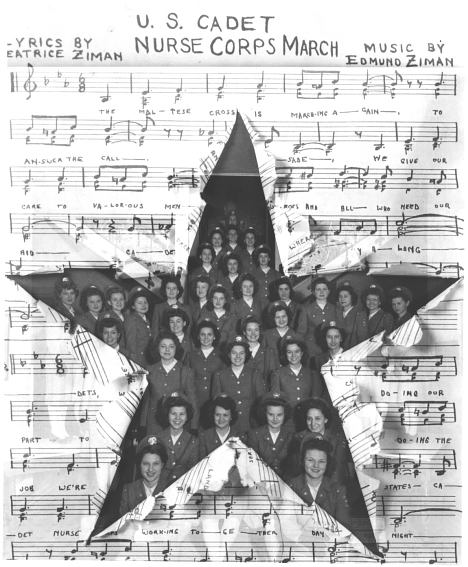
(Picture Courtesy: Pamela Burkholder)
.
[ I. Development
]..[ II.
Facts about the CNC ]..[
III. Uniforms ]..[
IV. Sources
]
|

